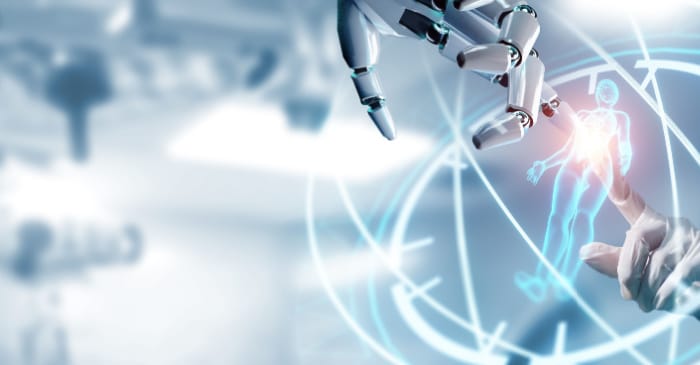
The Half-Way Mark: What Can We Expect from COP28?

Mastering Public Affairs and Government Relations: China
AI in Healthcare
December 2023

As in many other industries, Artificial Intelligence (AI) is poised to revolutionise healthcare across the Asia Pacific region, offering innovative solutions to address the complex challenges faced by its diverse and populous jurisdictions. As territories strive to enhance healthcare accessibility, affordability, and quality, AI applications are already playing a pivotal role in transforming the landscape of medical services, while in the future, they can be anticipated to do much more.
Until recently, healthcare’s use of AI has not been readily visible to the general public, largely consisting of R&D applications such as the analysis of molecules. However, this changed during the pandemic, when AI proved invaluable in assisting with COVID-19 diagnoses and helping researchers understand the variations in spike protein. Underscoring its growing importance, in October, the World Health Organization (WHO) acknowledged the role of AI in advancing global health, including medical diagnosis and treatments, through a new publication. It is now predicted that global spending on AI in healthcare will grow at a compound annual growth rate (CAGR) of 29 percent and reach USD 13.8 billion in 2027.
In this article, we delve into a variety of ongoing and anticipated applications for AI in healthcare, especially in challenging therapeutic areas, and the approaches that some of the key markets are taking for AI governance.
Emerging approaches in healthcare’s AI-powered future
There are many exciting areas in which AI is being or will be utilised in the healthcare domain, reshaping the future of the sector, including:
Monitoring and early detection: Currently, the most popular use for AI in the medical field is image analysis. By analysing CT scans, X-rays, MRIs, and ultrasounds, AI can make inferences and predictions much more quickly and accurately than doctors, allowing doctors more time with patients. In addition, wearable smart devices can continuously monitor patients’ glucose levels, heart rates, and neurological health to detect abnormalities and recommend treatment. As the use of image analysis and smart devices increases, medical problems can be detected much earlier. We could therefore see a shift in healthcare provision toward more preventative care or earlier treatment, which would then reduce the demand for later-stage, more invasive procedures.
Clinical trials: AI is also becoming a cornerstone in clinical trials, reshaping traditional methodologies and accelerating drug development. AI’s integration into clinical research has marked a significant shift, making trials more efficient and cost-effective. This technological advancement is particularly evident in the automation of laborious tasks like data collection, analysis, and patient selection, which traditionally consumed significant time and resources. The resultant acceleration in drug development not only reduces costs but also fast-tracks the delivery of life-saving drugs to the market. The technology is revolutionising patient recruitment and management too, enabling better trial designs and remote monitoring. By efficiently parsing through extensive patient data, AI algorithms can identify the most suitable candidates for trials, thereby improving the quality of the participant pool. This precision in recruitment is complemented by AI’s ability to predict potential adverse reactions, further enhancing the safety and efficacy of the trials.
Medicine development: Using AI, new medicines can be discovered much faster, at much lower cost, and with much higher success rates. Bringing a new medicine to the market currently takes up to 10 years, costs an estimated USD 1 billion, and requires the synthesis of more than 5,000 molecules. However, as AI creates new molecules virtually (in silico) the number of molecules that need to be synthesised can be reduced to 250, resulting in significant time and cost savings. Hence, AI medicine development has the potential to generate considerable revenue for pharmaceutical companies.
Tools to assist healthcare workers: Technological tools that were not specifically designed for the healthcare industry can assist hospital personnel with various tasks. Basic customer services dealing with queries can be performed by an online chatbot, and useful information can easily be gleaned through intelligent document processing. Using voice-to-text applications and language learning models (LLMs), in-person and remote medical encounters can be transcribed and summarised so healthcare workers only need to review the output. Ultimately, AI can relieve healthcare personnel from administrative responsibilities that would otherwise take up the bulk of their time and cause major burnout.
Decentralised machine learning: Traditional methods of analysis are not as advanced as trained algorithms in using complex data sets to identify subtle correlations or even deliver insights into the cause of a disease. For proper AI training, datasets need to be large and comprehensive, which means they need to draw patient records from multiple medical institutions. Using an emerging technology called swarm learning, it would no longer be necessary to keep all these data in a central repository. Patient data does not have to leave a medical facility – instead, the AI model would go to each facility to train on its data. This technology enables hospitals to retain sovereignty over their own data and would prevent the security and confidentiality of patients’ records from being compromised.
Mental health: In the future, we could see AI playing a role in fields we did not think possible. One such field is mental health. For the time being, the closest we have come to “virtual counselling” is in the form of wellness apps, such as Wysa, Heyy, and Woebot. These platforms offer chatbots that users who suffer from anxiety and depression can talk to as a first point of contact and can then refer them to a human therapist when queries escalate. However, the bots are trained with preset questions and answers, which greatly differ from generative AI such as ChatGPT which gleans its training data from all over the internet to provide original answers that more closely resemble a real-life conversation. Indeed, some people suffering from anxiety and depression have reported successfully using ChatGPT for counselling. Still, generative AI’s ability to truly empathise with a subject is still unknown. What’s more, whereas wellness apps’ preprogramming has safety checks in place, there is no way to guarantee the safety of responses provided by generative AI. At this stage, as the potential of AI in therapy is still riddled with problems, we might find its most valuable uses behind the scenes, such as mental health research, patient assessment, and monitoring patients’ progress. However, in the future, AI may have ambitious direct applications for mental health.
AI for difficult therapeutic areas
AI has the potential to make significant breakthroughs in difficult treatment areas in a variety of ways. Some highlights in the Asia Pacific region include:
Cardiovascular diseases (CVD), while preventable, are the leading cause of death in Asia Pacific, with over 9.85 million annual deaths per year in Southeast Asia and the Western Pacific. Moreover, this rate is expected to climb given lifestyle changes and aging populations in many territories throughout the region. In that context, AI is particularly welcome as a tool to enhance healthcare practitioners’ capabilities in tackling this problem. Given the large amounts of research and clinical information on CVD generated from diverse sources, AI is uniquely well-positioned to perform accurate data processing and generate deeper predictive insights. In that vein, the National Heart Centre Singapore (NHCS) opened a cardiac imaging research laboratory in 2022 that leverages data drawn from different imaging methods, such as CT, MRI, and nuclear imaging to improve the efficiency of CVD diagnosis. In 2023, the Chiba Institute of Technology in Japan signed an agreement with the Icahn School of Medicine at Mount Sinai to enhance CVD-related clinical trials, advance patient care, and bring potential new treatments to CVD patients. Such ventures are just the beginning, as the market for AI CVD solutions is expected to increase rapidly, particularly given the ubiquitousness of cardiovascular issues in modern societies. Globally, the AI Cardiology market was valued at USD 700 Million in 2022 and is expected to increase at a CAGR of around 38 percent from 2022 to 2030.
Neurological illnesses are another area where AI is increasingly being deployed to enhance treatment methodologies in Asia. AI algorithms play a pivotal role in analysing medical images relevant to neurological diseases, including brain MRIs, CT scans, and retinal images. By facilitating early detection and diagnosis of conditions such as stroke, brain tumours, and various neurological disorders, these AI algorithms can be effectively utilised by healthcare professionals to enhance patient care and management. One notable advancement in this field is the development of AccuBrain® by the Chinese University of Hong Kong. As the first clinically applicable AI-assisted brain imaging assessment tool in Asia, AccuBrain® helps to detect early neurodegenerative cognitive disorders such as Alzheimer’s disease and small vessel disease. AccuBrain® comprises three MRI sequences and surpasses regular brain MRI performance, serving as an effective tool for early detection and risk estimation of various neurological illnesses. Not only is AI used to accelerate the early detection of neurological diseases, but it can also be used to enhance rehabilitation for individuals with neurological conditions. AI is being increasingly used in the field of rehabilitation, enhancing individuals’ rehabilitation journeys through the implementation of personalised and adaptive therapeutic solutions. AI-powered assistive devices and customised rehabilitation plans have emerged as key highlights in this innovative landscape, supporting and empowering individuals with care that is tailored to their unique needs and challenges.
Strategies for AI governance
The rollout of AI in healthcare poses a variety of complex challenges to regulators. Two key Asia Pacific markets highlight different approaches toward AI:
Australia’s major medical associations like the Australian Medical Association (AMA) and the Royal Australian College of General Practitioners (RACGP) are advocating for stringent governance in healthcare AI. They point out the current challenges, such as AI’s largely unregulated nature, the opacity surrounding the ethical principles of AI developers, and the need for more concrete governance structures. The AMA’s response to a recent discussion paper, Safe and responsible AI in Australia, particularly highlights these issues. The RACGP also stresses the necessity for regulations to evolve in tandem with the rapidly advancing AI technologies, especially in areas like clinical interpretation and treatment recommendations.These developments underscore the complexity of regulating AI in healthcare within Australia. There is a clear call for a balanced approach, one that not only ensures patient safety and privacy but also encourages the innovative application of AI in healthcare settings.
China’s government seeks to strike a balance between innovation and oversight, reaping the benefits of ambitious AI utilisation while maintaining the sovereignty it has established over the country’s digital environment. China released its first regulations on generative AI in April this year, which require generative AI products to be registered with the country’s Cyberspace Agency and undergo a security assessment before being released to the public. In the past three years, China has rolled out several other measures affecting the use of AI technology, including the creation of the Data Administration Agency to reap the potential of the country’s vast and ever-growing pool of data. Other measures to regulate AI technology include launching China’s first Personal Protection Information Law (PIPL) in November 2021 and setting up an Algorithm Registry in March 2022. Regarding healthcare specifically, the government has also begun implementing AI quality control regulations. The Center for Medical Device Evaluation (CMDE) of the National Medical Products Administration (NMPA) issued the Guidance for the Classification Defining of AI-Based Medical Software Products in 2021 followed by the Guiding Principles for the Registration Review of Artificial Intelligence Medical Devices six months later. Overall, China is hoping that its AI regulations could serve as a model for other countries to follow and even proposed its Global AI Governance Initiative at the Third Belt and Road Forum for International Cooperation in October.
Looking ahead
As we continue to proceed in this new period of booming AI-empowered advancements, MNCs are well advised to monitor the ways these technologies are deployed in healthcare sectors across the Asia Pacific region. Promising to upend existing paradigms, AI can be expected to play an integral role in shaping the future of the healthcare and biopharmaceutical domains. At the same time, regulatory scrutiny should be closely monitored, as different governments may take divergent strategies toward managing this emergent field.




